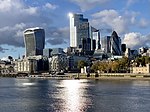The City of London is a city, ceremonial county and local government district that contains the historic centre and constitutes, alongside Canary Wharf, the primary central business district (CBD) of London. It constituted most of London from its settlement by the Romans in the 1st century AD to the Middle Ages, but the modern area named London has since grown far beyond the City of London boundary. The City is now only a small part of the metropolis of Greater London, though it remains a notable part of central London. Administratively, the City of London is not one of the Greater London boroughs, a status reserved for the other 32 districts (including Greater London's only other city, the City of Westminster). It is also a separate ceremonial county, being an enclave surrounded by Greater London, and is the smallest ceremonial county in the United Kingdom.
The City of London is widely referred to simply as the City (differentiated from the phrase "the city of London" by capitalising City) and known as the Square Mile, as it is 1.12 sq mi (716.80 acres; 2.90 km2) in area. Both of these terms are also often used as metonyms for the United Kingdom's trading and financial services industries, which continue a notable history of being largely based in the City. The name London is now ordinarily used for a far wider area than just the city. London most often denotes the sprawling London metropolis, or the 32 Greater London boroughs, in addition to the City of London itself. This wider usage of London is documented as far back as 1888, when the County of London was created.The local authority for the City, namely the City of London Corporation, is unique in the UK and has some unusual responsibilities for a local council, such as being the police authority. It is also unusual in having responsibilities and ownerships beyond its boundaries. The corporation is headed by the Lord Mayor of the City of London (an office separate from, and much older than, the Mayor of London). The Lord Mayor, as of November 2021, is Vincent Keaveny. The City is made up of 25 wards, with administration at the historic Guildhall. Other historic sites include St Paul's Cathedral, Royal Exchange, Mansion House, Old Bailey, and Smithfield Market. Although not within the City, the adjacent Tower of London is part of its old defensive perimeter. The City has responsibility for five bridges in its capacity as trustee of the Bridge House Estates: Blackfriars Bridge, Millennium Bridge, Southwark Bridge, London Bridge and Tower Bridge.
The City is a major business and financial centre, and the Bank of England is headquartered in the city. Throughout the 19th century, the City was the world's primary business centre, and it continues to be a major meeting point for businesses. London came top in the Worldwide Centres of Commerce Index, published in 2008. The insurance industry is located in the eastern side of the city, around Lloyd's building. A secondary financial district exists outside the city, at Canary Wharf, 2.5 miles (4 km) to the east.
The City has a resident population of 9,401 (ONS estimate, mid-2016) but over 500,000 are employed there, and some estimates put the number of workers in the City to be over 1 million. About three-quarters of the jobs in the City of London are in the financial, professional, and associated business services sectors. The legal profession forms a major component of the northern and western sides of the city, especially in the Temple and Chancery Lane areas where the Inns of Court are located, of which two—Inner Temple and Middle Temple—fall within the City of London boundary.












